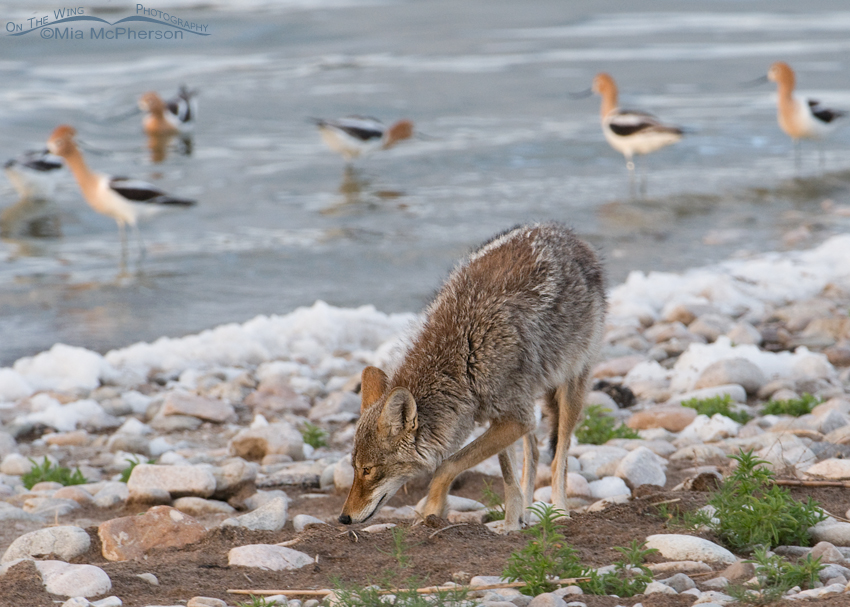 Coyote sniffing the ground
Coyote sniffing the ground
I have often said “you won’t know unless you go” and yesterday was another time that theory proved to be true. To get to Antelope Island there is a seven mile long causeway which often has birds on both sides of it, this time of the year there are quite a few shorebirds and gulls that are feeding on brine flies. The American Avocets behind the Coyote in the frame were sounding their distress calls, they didn’t like it being so close to them. (That isn’t snow or ice on the edge of the water, it is sea foam)
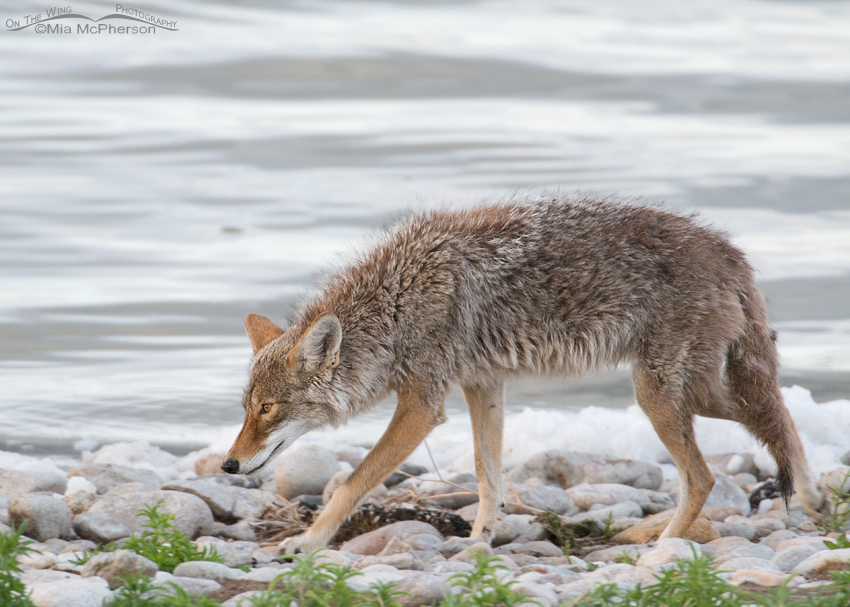 Coyote hunting on the causeway
Coyote hunting on the causeway
I’m used to seeing Coyotes along the causeway during the winter when they are scavenging falcon left overs but I am always pleasantly surprised when I see one during the spring or summer, yesterday I spotted one on the north side of the causeway and after we turned around it moved over to the south side. There were clouds overhead and to the east so the light wasn’t “golden” but there was enough light to take these images.
 By now I am wondering what the Coyote is looking for
By now I am wondering what the Coyote is looking for
The Coyote kept sniffing the ground as it wandered along and I wondered what it was looking for. I haven’t seen the falcons recently on the causeway so I doubted that there were any left overs from them. The Coyote wasn’t trying to move to or from the island, if it had been it would have been moving fast and making tracks.
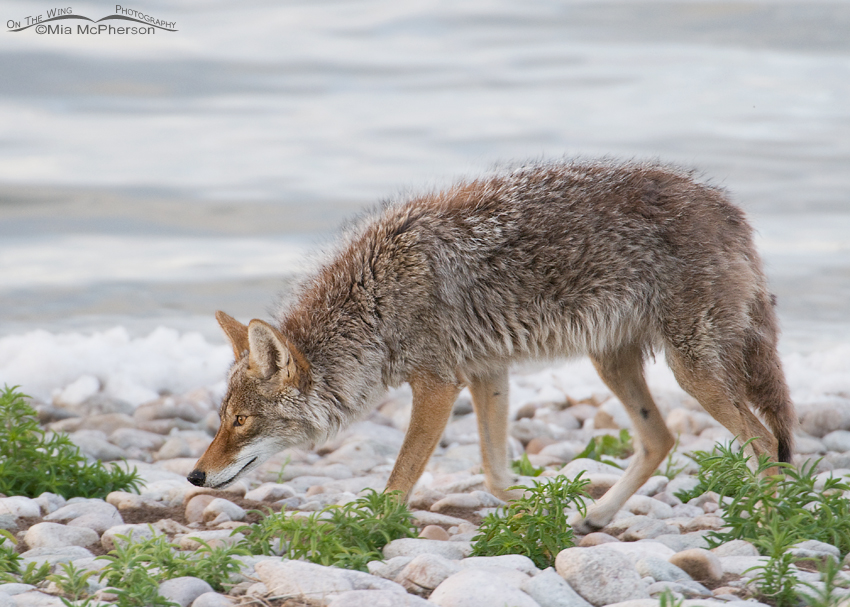 Sunrise in a Coyote’s eyes
Sunrise in a Coyote’s eyes
Despite wondering about what the Coyote was looking for I kept taking images of the Coyotes while listening to the calls of the disturbed American Avocets nearby. I was surprised that the Avocets didn’t just fly off.
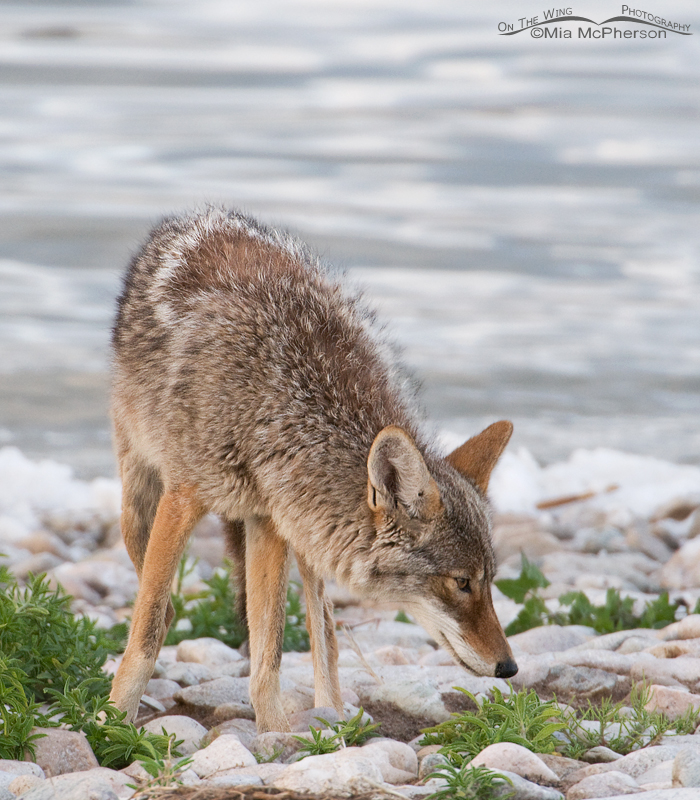 What is the Coyote looking for?
What is the Coyote looking for?
I admit I was puzzled. I didn’t see the Coyote picking anything up, it wasn’t acting like it was on the trail of voles, it just meandered sniffing the ground.
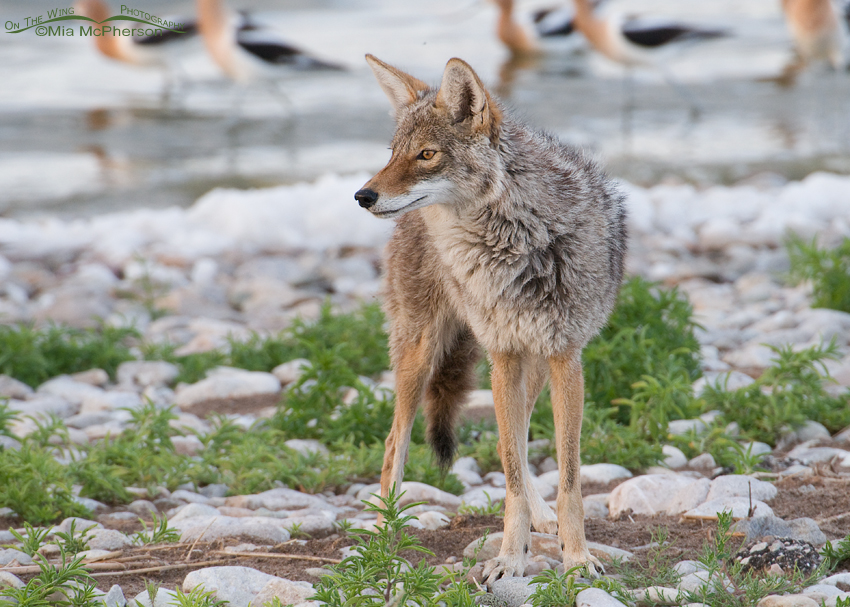 Coyote with American Avocets in the background
Coyote with American Avocets in the background
Some times the Coyote would stop and stare off into the distance giving me great views of its amber colored eyes. I noticed that the Coyote has its sleek summer coat on its face and legs but still hasn’t lost the winter coat on most of its body.
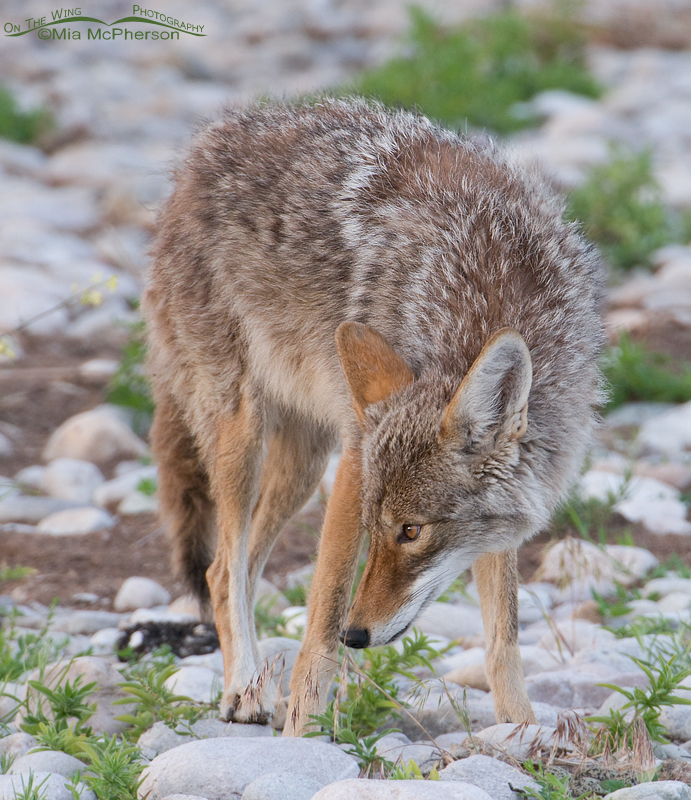 Can you see what the Coyote was after?
Can you see what the Coyote was after?
Then the Coyote stopped and through my lens I could see what the coyote was after. I started taking more images while telling Ron what the Coyote was after because he couldn’t see it. Can you see it yet? The next image will show what it was a bit more clearly.
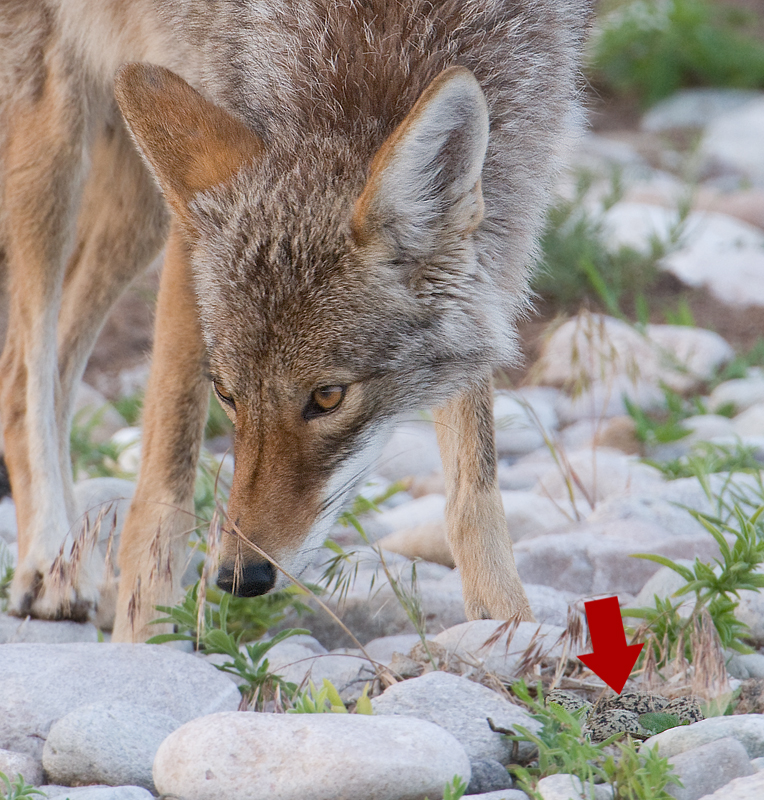 Look at the red arrow next to the Coyote
Look at the red arrow next to the Coyote
There were four eggs in a scrape on the ground, with their coloration and speckles they were barely noticeable. About that time I looked east and saw an American Avocet in the distance with an egg in its bill, it had to have been an egg shell from a chick that had already hatched because an unhatched egg probably would have been too heavy.
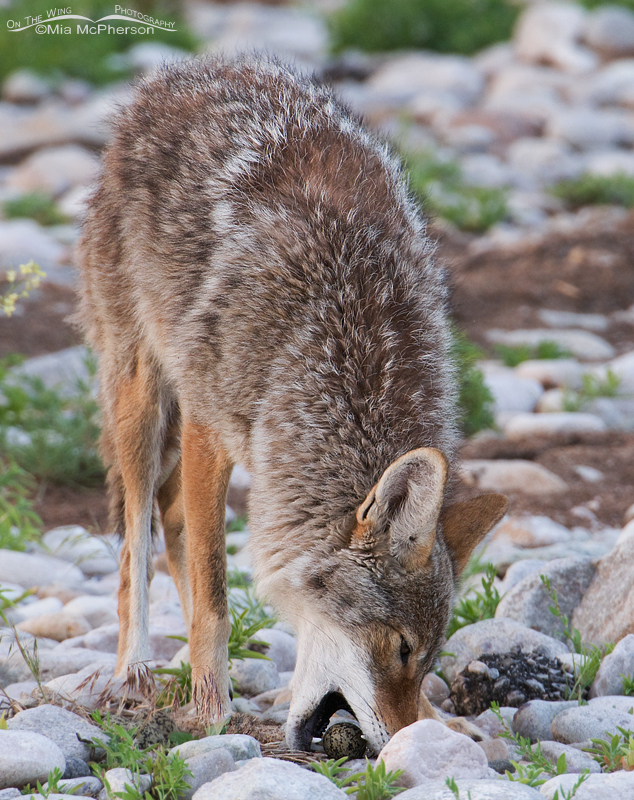 Coyote picking up an egg, probably an American Avocet egg
Coyote picking up an egg, probably an American Avocet egg
I am fairly certain that these eggs are American Avocet eggs although I saw some Killdeer in the area they weren’t sounding alarmed, in fact they weren’t making any noise at all. Until yesterday I had no idea at all that the Avocets were nesting along the causeway.
In this frame the Coyote was picking up one of the eggs.
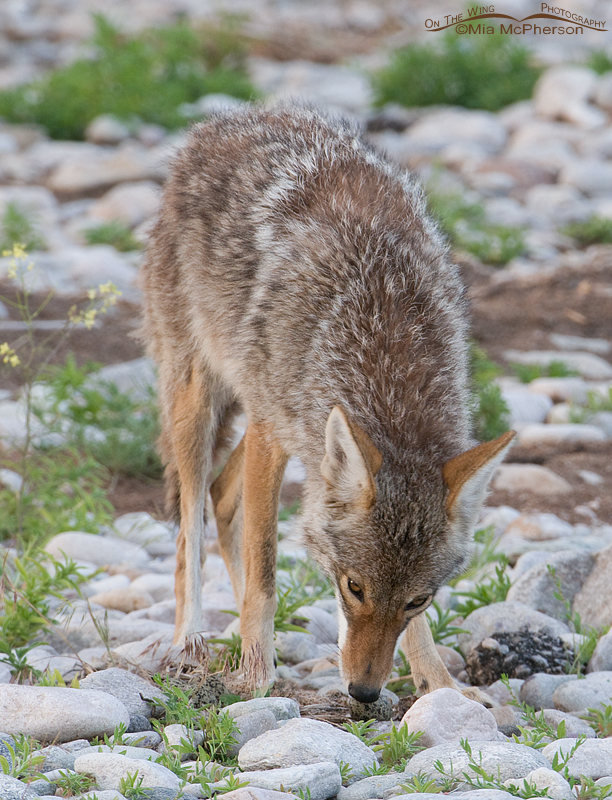 Coyote staring
Coyote staring
And in this frame it was looking up at us with its mouth on the egg. I think those amber colored eyes are beautiful and mesmerizing.
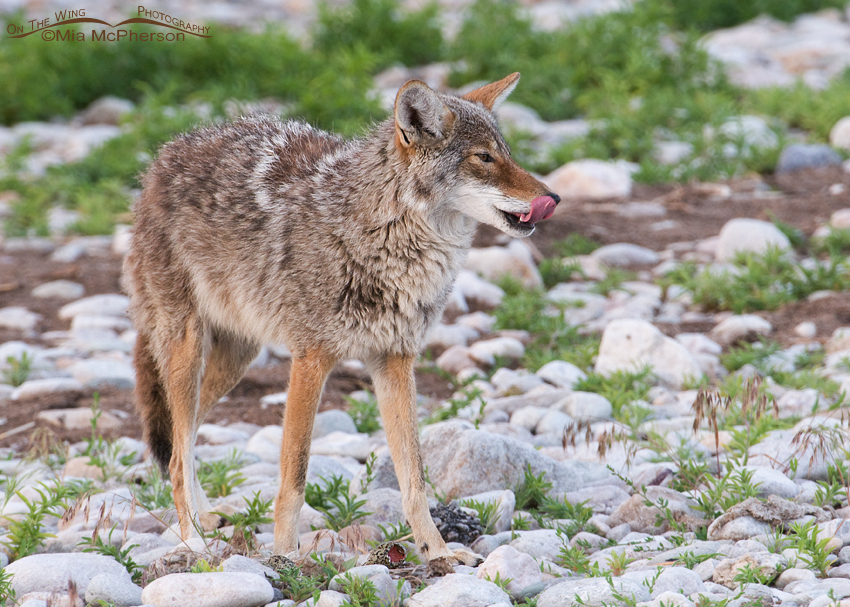 Nom nom nom
Nom nom nom
In this frame the partially eaten is visible near the Coyote left foot and another is near the right foot. The partially eaten egg shows blood so it wasn’t just freshly laid, it may have been closer to time for it to hatch.
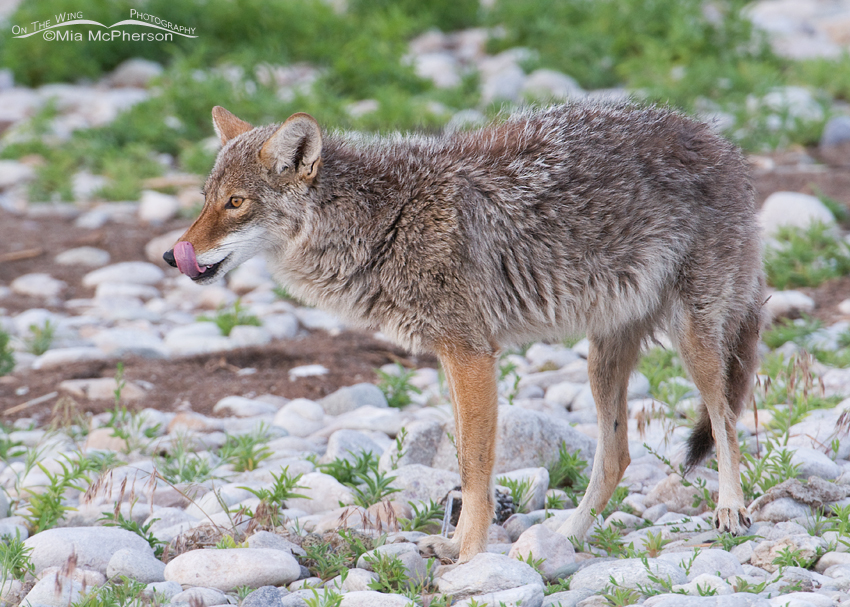 One egg finished
One egg finished
The Coyote finished the first egg and I thought it would eat any of the others in the nest but it didn’t, it licked its mouth and started moving again. I’m curious about how why the Coyote didn’t eat all of the eggs in the nest. I’m also curious about if the Coyote used sight or smell to locate the first egg.
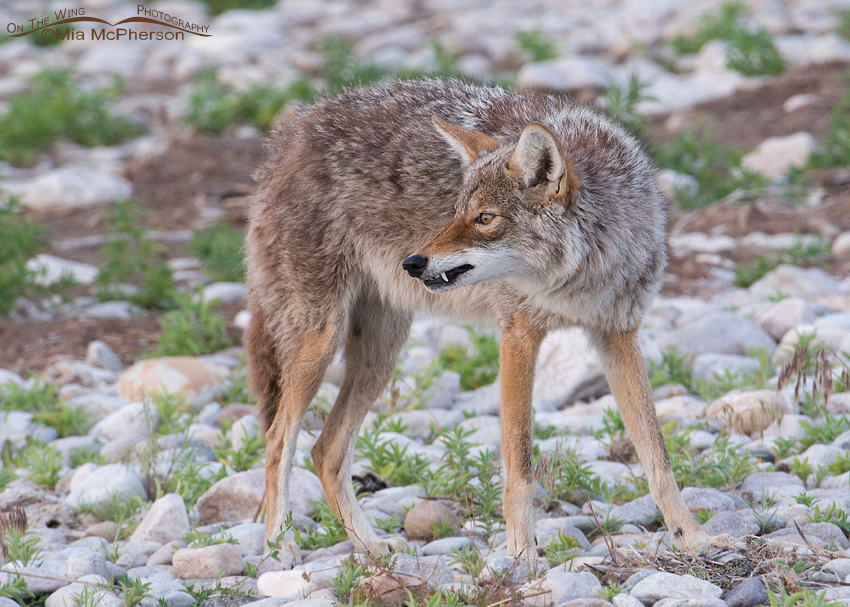 Coyote at a second nest
Coyote at a second nest
The Coyote wandered west for a bit, keeping its head low to the ground and then it stopped to look around. There is an egg in front of the Coyote’s left foot in this frame.
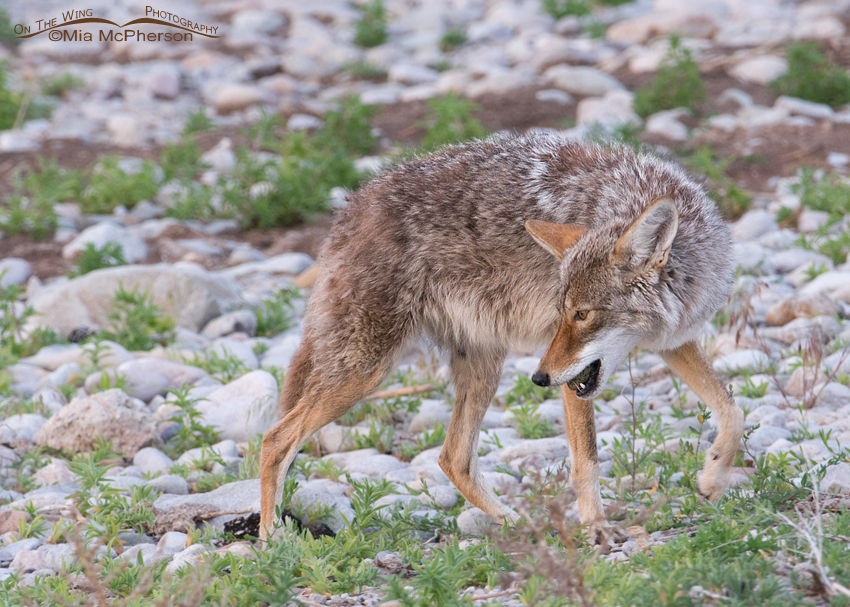 Coyote with the egg in its mouth
Coyote with the egg in its mouth
Instead of eating this egg though the Coyote took it into its mouth…
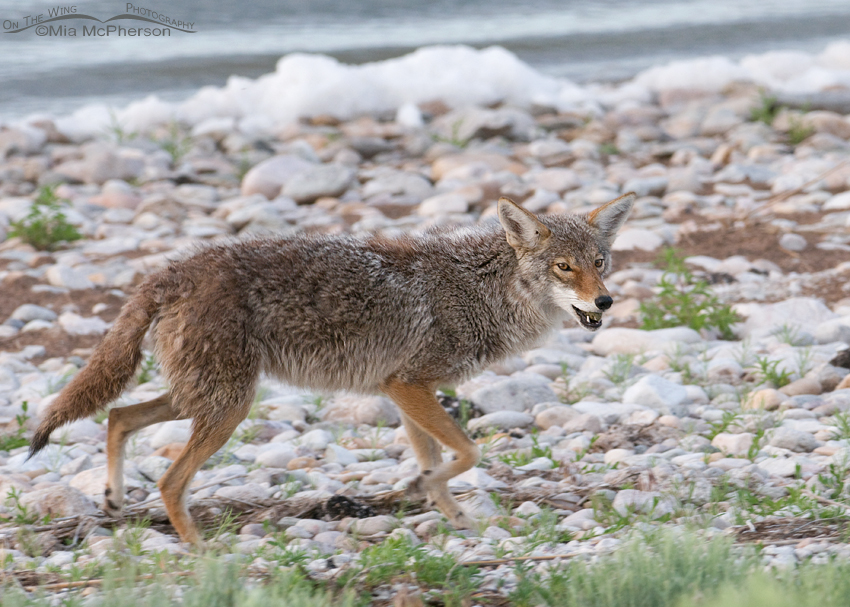 Moving down the causeway with the egg still in the Coyote’s mouth
Moving down the causeway with the egg still in the Coyote’s mouth
And headed west towards the island. It traveled a distance, perhaps more than 75 to 100 feet, with the egg in its mouth and at that point I thought it might be carrying the egg back to its young.
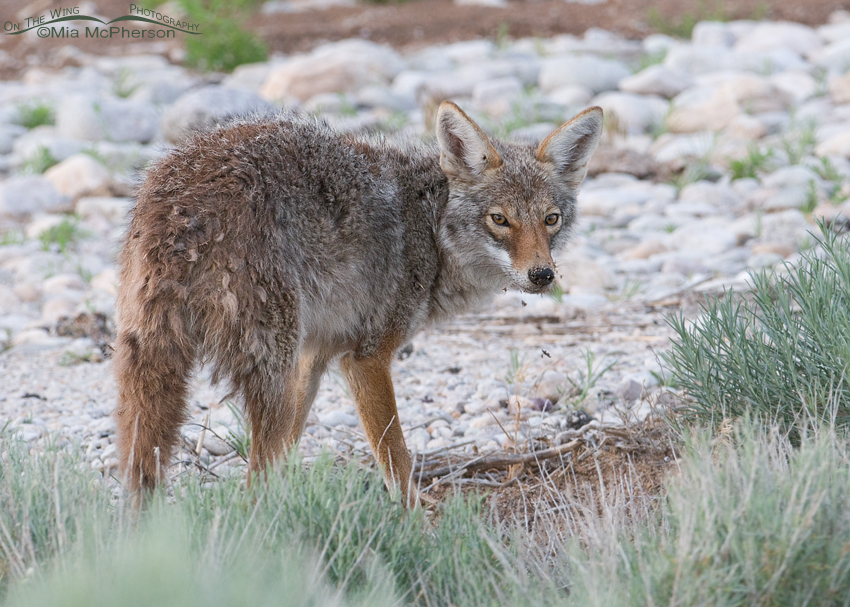 Coyote after hiding the egg
Coyote after hiding the egg
Then it stopped, gently placed the egg on the ground and with its muzzle pushed dried vegetation and sand over the egg. After it covered the egg it gave us a brief look and headed west again. I’ve heard of Coyotes caching food but I don’t think I have ever heard of one caching an egg.
It was a fascinating experience to see and photograph this Coyote locating and eating the egg and I’m tickled to have witnessed the Coyote’s egg carrying behavior plus once again I am very glad to have been in the right place at the right time.
Life is good.
Mia
Click here to see more of my Coyote photos plus facts and information about this species.


Mia, a great series! What a beautiful creature!
I got my first really good look at a pair of Florida coyotes last week. Usually, I see them in high gear as they disappear into the scrub or woods. This pair was in a pasture stalking Sandhill Cranes. The cranes eventually chased them away. It was a rare time that I didn’t have the camera with me. Sigh…….
Wonderful photographs!
This is wonderful and fascinating. And beautiful.
Thanks zephyr!
You really caught me up in the story….fascinating. Beautifully photographed, perfect “captures” of the moments. Thanks for sharing.
Thank you Carol!
Unbelievable series you captured here, Mia! It’s such a treat to get a representation of novel behavior that’s also accompanied by stellar images! To get one or the other would be task enough! I’m fascinated by the coyote caching an egg. Wow. What documentation. I admit, no matter how much I’ve seen, I’m still hyper-sensitive to the situation of the prey animals, too. I feel for those Avocets. I obviously care about coyotes, too, though. I’m always amazed that ground-nesting birds can raise young to adulthood. It’s such a precarious placement they’re forced into. Anyway, again, just a jaw-droppingly beautiful post.
Ingrid, I felt for the Avocets but I also know the Coyote needed the food. The caching of the egg was fascinating to me.
Mia, your images are so beautiful. It’s just like being there, kinda. I’d love to visit Antelope Island, and wouldn’t even mind seeing a nest raiding Coyote, now that you’ve given some descriptive dialog to the prey dog’s bad behavior. Love the coat on this scavenger. Looks like he/she should be further north, like in Alaska. Very fun series. Thank you for the ride along.
I’d love to visit Antelope Island, and wouldn’t even mind seeing a nest raiding Coyote, now that you’ve given some descriptive dialog to the prey dog’s bad behavior. Love the coat on this scavenger. Looks like he/she should be further north, like in Alaska. Very fun series. Thank you for the ride along.
Kelly, I hope you get to visit Antelope Island, it is an amazing place.
Amazing, awesome, fascinating, and wonderful series, Mia! We see so much through your lens.
Thank you Julie!
Mia, what an amazing experience! It is so fortunate that you were able to capture so much of it with your camera. I figured out the coyote was looking for eggs, but I was surprised that it didn’t eat them all and that it carried one off and cached it. I also wonder if it heard the tiny chick inside the egg moving around and that was how it found it? Nature is wonderful and powerful to behold. You and I both know this very well!
Thank you Kathie, this was an amazing experience! Befuddled me a bit when the Coyote cached the egg though.
Mia, this is very cool! This place sounds and looks like paradise!! Great story with the pics. They are such interesting creatures. I enjoy seeing them in the wild. As for this Antelope Island…..:)
Chris, you have to come visit Antelope Island, ask Kathie, you will LOVE it! Thanks for your comment.
Wonderful story and beautiful set of photos to document it so nicely. Well done!!
Thank you Gordon and thanks for visiting my blog too!
Wonderful photos series Mia! I love coyotes, and these photos are superb!
Thanks Linda, Coyotes are a favorite of mine so I was thrilled to experience and photograph this event.
I definitely think it was his sense of smell all the way. Canines are prodigious for it, and that’s why the “K-9’s” are used for police work. Even when K-9 dogs are trained by humans; they still couldn’t do it without this olfactory organ genetic constitution. The mature eggs also involved more olfactory stimulus, than the fresh eggs. As I suspected, when I read about the Jacobson’s organ in reptiles; it also applies to mammals. But canines seem to have an additional advantage; and that is in the way the breathe in an out of their noses. As they inhale, the air splits in two directions (see these diagrams 1 &3 in this article: http://www.pbs.org/wgbh/nova/nature/dogs-sense-of-smell.html One part of the air goes to the olfactory organ; the other to its lungs. When dogs exhale, the air swirls out through the slits in the sides of their noses (see diagram 3). This helps usher new odors into the dog’s nose thus amplifying drastically the acuteness and range for scent. Great post!
Thank you for the comment and the information Maria.
What a lovely photo narrative, Mia. This is completely fascinating and your pix are lovely!
Thanks Lynn.
Beautiful images Mia! Thanks for sharing your blog link on Natureshare/Audubon Birds. Your work is amazing
-Omnitrigger
Thank you Omnitrigger and thanks for visiting my blog too.
Fascinating post, Mia!
Thanks Beverly!
You are right it is fascinating and they do cache food often, probably more than we realize. I love when I’m shooting and get to witness activities I didn’t know were going on! Great series and I’m glad you narrated it for us!
Thank you Sherry, it was a super experience for me.
Never mind the perfect shot of the coyote (which is still on my list to get) in the that first picture, you have avocets in the background (which are also still on my list)! I have a friend that lives in Denver. I think I’ve just been motivated to get out there to visit her and do some sight seeing.
Sad about the eggs but I guess it’s true. Weird he didn’t eat all of them.
Thanks Dina. You’ll love Colorado, I have lived there twice and enjoyed it very much.
Mia, those at just fantastic!!!! Beautiful photos!
Thank you Judy!
stunning serie, you have followed him in each action =))
well done mia, bravo
Thanks so much Eric!
These are such beautiful shots. I think it’s just amazing how the Coyote was able to find those eggs. And he seemed like he knew what he was looking for the whole time.
Thanks Taylor, those eggs sure blend in well with the habitat, most ground nesting bird eggs doo. I was surprised to see the Coyote hide the unbroken egg though!
Terrific photos and observations Mia ! Again like everyone else, wish we could have been there. Thanks for giving us the next best thing.
Thanks John, I wish everyone could have seen this too.
That is truly awesome Mia. Those amazing images tell an incredible story. Congratulations for being so dedicated to your art that you were in the right place at the right time. I would have been tempted to try to find the egg and take it back to the nest, how silly is that!
Kim, thanks so much for your comment! I was so tickled to be right where I needed to be to see this Coyote and its behavior! I felt bad for the Avocets but I know this is the cycle of nature.
Awesome post Mia! You showed me something that I have never seen a Coyote do and that is to hide an egg.
Steve, I wish you could have been there with us to see this behavior, it was fascinating!